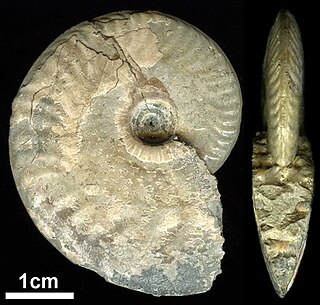Uhligites is an oppeliid ammonite included in the subfamily Streblitinae that lived during the latest part of the Jurassic and earliest Cretaceous; from about 150 to 140 m.y.a.
Haplopleuroceras is a Middle Jurassic ammonite and likely member of the Hildoceratacean family Sonniniidae with which it shares the same sort of ribbing.

Stephanoceratoidea, formerly Stephanocerataceae, is a superfamily of middle- upper Jurassic ammonoid cephalopods within the order Ammonitida containing diverse forms, generally with sharp ribbing and complex suture lines. Aptychi are believed to be mostly granular (Granulaptycus) or concentrically ribbed on the surface (Praestriaptychus)

Eoderoceratoidea is a superfamily of true ammonites from the Lower Jurassic, comprising seven phylogenetically related families, characterized in general by having ribbed evolute shells that commonly bear spines or tubercles. Adult shell size ranges from 2 or 3 cm to giants reaching 50 cm in such genera as Apoderoceras, Epideroceras, and Liparoceras.

Eoderoceratidae is the ancestral and most primitive family of the Eoderoceratoidea; lower Jurassic ammonite cephalopods, characterized by evolute, commonly serpenticonic, shells that had long body chambers and would have had no stable floating position; and thus resemble contemporary Psiloceratoidea. Spines, or tubercles, are typically found in two rows on the inner and outer parts of the whorl sides, joined by radial ribs. These are often more developed on the inner and middle whorls, becoming less so or absent on the outer. Sutures are highly complex.
Phricodoceratidae is a family in the Eoderoceratoidea, aberrant ammonites from the Lower Jurassic characterized by a large adult size and a marked change of shell form and ornament with growth. Shells are stoutly ribbed, early growth stage is round-whorled with spines, followed by a high-whorled late growth stage with smooth, modified ribbing.
Coeloceratidae is a family of ammonites belonging to the Eoderoceratoidea that lived during the Early Jurassic. Shells are evolute, tending to be broadly discoidal with depressed whorls bearing primary and secondary ribs that branch from outer lateral tubercles. Most of the included species have coronate inner whorls and outer tubercles only. In general, Coeloceratids resemble the Middle Jurassic Stephanoceras. Once regarded as the subfamily Coeloceratinae in the Eoderoceratidae, these ammonites are now given familial rank.

Liparoceratidae is a family of eoderoceratoidean ammonites from the Lower Jurassic that combines genera with a variety of forms including dimorphs that change from one form to another during ontogeny.

Perisphinctoidea, formerly Perisphinctaceae, is a superfamily of Middle Jurassic (Bajocian) to Lower Cretaceous (Barremian) ammonites, commonly with evolute shells with strong ribbing that typically divides about mid flank before crossing the venter.
Pachyceratidae is a family of Perisphinctoidean ammonites from the upper Middle - and lower Upper Jurassic. Genera within the Pachyceratidae have shells that are in general moderately involte but with most of the inner whorls exposed; whorl sections subquadrate to subtrapezoidal, with rounded venter. Ribbing is strong, in some sharp. Primary ribs typically branch above mid flanks into twos, threes, and even fours.
Crucilobiceras is an ammonoid cephalopod genus from the Lower Jurassic belonging to the eoderoceratoidean family Eoderoceratidae. Cruciliboceras has an evolute shell, such that all whorls are well exposed, with persistent radial ribbing and with spines or tubercles on the outer, ventral, rim, and in some, tubercles in the inner, umbilical, rim. The genus Crucilobiceras is commonly found along the Jurassic Coast of England.
The Haploceratidae is the type family of the Haploceratoidea, a superfamily in the ammonitina; which according to Donovan et al. (1981) can be derived from the Taramelliceratinae, a subfamily of the Oppeliidae.

Oppeliidae are compressed to oxyconic, sculptured Haploceratoidea, either unkeeled, unicarinate, bicarinate, or tricarinate; with sutures in great variety, but ribbing usually more or less falcoid or falcate. The Oppeliidae is the principal family of the Haploceratoidea, with the longest duration, extending from the Middle Jurassic (Bajocian) to the Upper Cretaceous (Cenomanian) Their derivation is from the Hildoceratoidea.

Hildoceratidae is a family of ammonoid cephalopods from the Lower Jurassic, lower Pliensbachian to lower Bajocian substages, generally with strongly ribbed, involute shells. They are combined with the Hammatoceratidae, Graphoceratidae, and Sonniniidae to make up the Hildoceratoidea.

Perisphinctidae is a family of Middle and Upper Jurassic discoidal ammonites in the order Ammonitida. They have a shell morphology that is mostly evolute, typically with biplicate, simple, or triplicate ribbing. Large forms have simple apertures and smooth body chambers while small forms have lappets and ribbed body chambers.
Hecticoceratinae is a subfamily of oppeliids from the Middle and Upper Jurassic typically with strong falcoid or falcate ribbing that covers whorl sides completely. Venters are usually keeled and may be tricarinate.
The Ochetoceratinae is a subfamily within the Oppeliidae from the Upper Jurassic, shells of which are typically oxycones with a tricarinate venter and falcoid ribbing, commonly divided by a median lateral groove or fillet. The median (middle) keel is the tallest.
Erycitidae is a family of Lower and Middle Jurassic ammonites included in the Hildoceratoidea. The hammatoceratid subfamily Erycitinae is equivalent. Genera include Erycites (type) and Abbasites.

Hammatoceratidae is a family of lower and middle Jurassic ammonites included in the superfamily Hildoceratoidea.

Hammatoceras is a genus of ammonites belonging to the family Hammatoceratidae which lived during the Toarcian stage of the Early/Lower Jurassic between about 184 and 175 million year ago.








